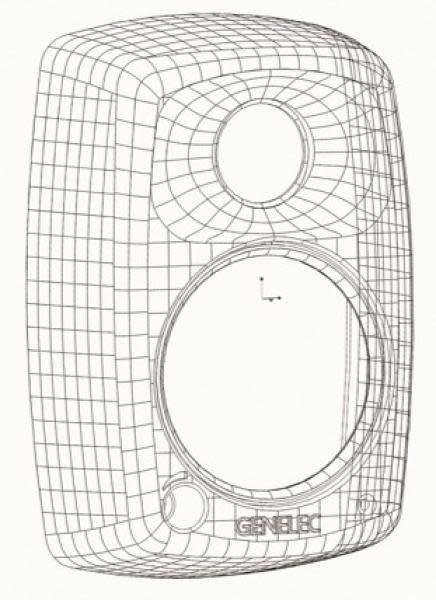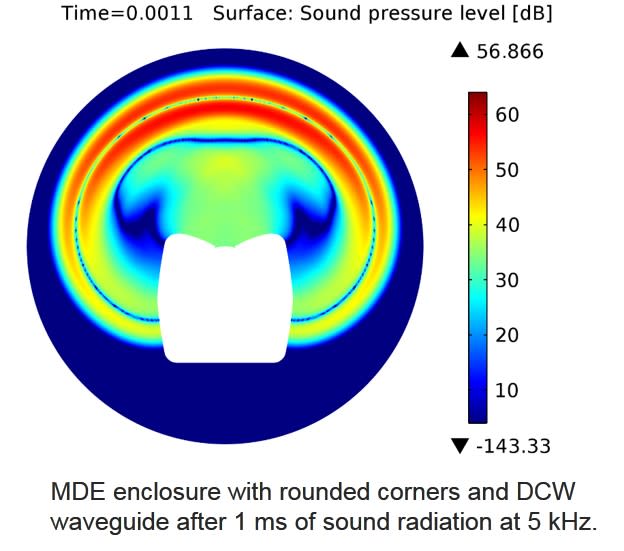For pro performance in a compact package, look no further. For small studio spaces and mobile recording, the 8010 is your genuinely truthful monitoring companion that will help spark your creativity too.
Products in this solution:

For pro performance in a compact package, look no further. For small studio spaces and mobile recording, the 8010 is your genuinely truthful monitoring companion that will help spark your creativity too.
Products in this solution:

The 8010A offers industry leading performance in its size category.
The 8010A is a very small studio monitor, but it has performance way beyond its size. There has been a tremendous amound of research and development put into the tiny speaker, and the end result is a real, high quality tool that you can use to make critical judgment calls about your audio.
The combination of extremely compact size, high quality audio reproduction, surprising levels of SPL, and solid bass extension down to 67 Hz mean that you can take them wherever you go and still work confidently, without missing anything.
The 8010A's are so small and portable that you can easily pack them in your backpack, carry-on luggage or, in a pinch, even toss them in a plastic bag.
The small size and robust aluminium enclosure means that the 8010A's can be packed and unpacked time after time, and continue to function without a hitch. When you take them out, all you need is a power outlet and an audio source with balanced outs.
No matter if you're going to an important meeting to demo your music to your customer, or if you want to share your latest ideas with your friends, the portability of the Genelec 8010A's make them the ideal high quality loudspeakers to take with you. We even have a carrying bag for them!



96 dB

67 Hz - 25 kHz (-6dB)

H 195 x W 121 x D 115 mm, with Iso-Pod™ (view in inches)

Active Crossovers

Room Response Compensation

Directivity Control Waveguide (DCW™) Technology

Intelligent Signal Sensing (ISS™) Technology

Iso-Pod™ Stand

Minimum Diffraction Enclosure (MDE™) Technology

Optimised Amplifiers

Protection Circuitry

Reflex Port Design

Versatile Mountings

Audio electronic crossovers allow the audio signal to be split into separate frequency bands that are separately routed to individual power amplifiers, which are then connected to specific transducers optimised for a particular frequency band.
Active crossovers come in both digital and analogue varieties. Genelec digital active crossovers include additional signal processing, such as driver protection, delay, and equalisation.
Genelec analogue active crossover filters contain electronic components that are operated at low signal levels suitable for power amplifier inputs. This is in contrast to passive crossovers that operate at the high signal levels of the power amplifier's outputs, having to handle high currents and, in some cases, high voltages.
In a typical two-way system the active crossover needs two power amplifiers — one for the woofer and one for the tweeter.
Using the active approach enables frequency response adjustments and optimisation of the full loudspeaker system, placed in various room environments, without expensive external equalisers. The end result is a simpler, more reliable, efficient, consistent and precise active loudspeaker system.

The interaction between room acoustic and loudspeaker radiation is complex. Each room changes somewhat the monitor’s response in a unique way, e.g. reflective vs. damped rooms, or placement against a wall vs. on a stand away from the walls.
All Genelec loudspeaker systems feature room response adjustments to compensate for the room influences and retrieve a flat frequency response at the listening position.
Genelec analogue loudspeaker systems provide versatile Room Response Controls. They include (depending on models):

At low frequencies two main controls are provided. The Bass Tilt control, which acts as a shelving filter together with the Bass Roll-off control allowing you to optimize the low and very low frequency response of the system in different installations. Bass, midrange and treble level controls are provided in large systems. These controls allow to optimize the relative balance between the various pass bands.
The operating manual and datasheet of each loudspeaker contains a list of preferred room response control settings for different installations. These have been specified out of long practical experience and measurements of various kind of typical acoustic environments.
Genelec SAM Systems offer a comprehensive, solution-oriented, intelligently networked product range which all feature Genelec Loudspeaker Manager (GLM™) software and its automatic calibration system called AutoCal™.
Genelec AutoCal provides the industry’s first integrated process for complete automated measurement, analysis, and adjustment of every monitor on the GLM control network. The system measures the response in the listening area and applies relevant compensation in the low and low-mid frequencies to minimise the detrimental room acoustic anomalies as well as the differences between various listening positions. AutoCal also aligns relative levels, time-of-flight, as well as adjusts correct crossover phase (called AutoPhase) for all subwoofers on the network.

The Acoustic Response Editor provides accurate graphical display of the measured response, filter compensation and the resulting system response for each monitor, with full manual control of acoustic settings.

A revolutionary approach was taken by Genelec in 1983 with the development of its Directivity Control Waveguide (DCW™). We have developed and refined this technology over more than 30 years to greatly improve the performance of direct radiating multi-way monitors.
The DCW technology shapes the emitted wavefront in a controlled way, allowing predictable tailoring of the directivity (dispersion) pattern. To make the directivity uniform and smooth, the goal is to limit the radiation angle so that the stray radiation is reduced. It results in excellent flatness of the overall frequency response as well as uniform power response. This minimises early reflections and provides a wide and controlled listening area achieving accurate sound reproduction on and off-axis.
Minimised early reflections and controlled, constant directivity have another important advantage: the frequency balance of the room reverberation field is essentially the same as the direct field from the monitors. As a consequence, the monitoring system's performance is less dependent on room acoustic characteristics.
Sound image width and depth, critical components in any listening environment, are important not only for on-axis listening, but also off-axis. This accommodates not only the engineer doing their job, but also others in the listening field, as is so often the case in large control rooms.

Introduced early 2013, Genelec’s Intelligent Signal-Sensing technology has been developed to meet with both European Union ErP Directives and Genelec's own ambitious sustainability standards.
The Intelligent Signal Sensing, ISS™ circuitry tracks the signal input of the loudspeaker and detects if it is in use. If the ISS circuit does not find any audio on the input for a period of time, it sets the loudspeaker to a low-power sleep state and the loudspeaker will consume less than 0.5 watts. When an input signal is detected, the loudspeaker immediately turns itself on.
Additionally an ‘ISS Disable’ switch is located on each product’s back plate next to the other room response controls. First, when the mains power switch of the loudspeaker is set to 'ON', the ISS™ auto-start function (low-power sleep state on/off) of the loudspeaker is active.

If this function is not desired, the ISS™ function can be disabled by setting the 'ISS Disable' switch on the back panel to 'ON' position. In this mode, the monitor is only powered on and off using the mains power switch.
Note that the mains power switch will always turn the monitor off completely.

Although it is advisable to use sturdy and stable floor stands together with free-standing loudspeakers, a very common solution is to place loudspeakers directly on a table or on a console meter bridge.
This causes several detrimental side effects. Aiming of the loudspeaker axis towards the listener is rarely implemented, also, unwanted mechanical vibration do propagate from the loudspeaker to the mounting surface, and first order reflection on the work surface causes comb filtering and hence ripples in the frequency response.
To solve these very common problems Genelec developed an efficient and very practical solution. We designed a loudspeaker stand called Iso-Pod™ - Isolation Positioner/Decoupler that is attached to the aluminium enclosure. It has four shallow feet and it is made from special lossy rubber-like material. It is firmly attached to the enclosure so that it can be slid along the curved bottom or side surface to allow for a ±15° tilt of the loudspeaker.
The loudspeakers’ acoustical axis can then be pointed precisely towards the listener by adjusting the enclosure’s inclination with the Iso-Pod. The vibration isolation and damping properties reduce midrange coloration caused by unwanted vibration transmitted to supporting surfaces.
This innovative solution is an integral part of Genelec loudspeaker design and provides clear benefits in usability and sound quality.

A common problem with standard free-standing loudspeakers is that the front baffle discontinuities cause diffractions and the loudspeaker sharp corners act as secondary sources through reflections.
In order to improve the flatness of the frequency response and the power response of free standing loudspeaker systems, Genelec have designed a highly innovative enclosure optimized to match the properties of the monitor drivers, featuring rounded edges, and gently curved front and sides. In addition to achieving an unsurpassed flatness of the frequency response, the enclosure having minimum diffractions yields superb sound stage imaging qualities.
To achieve such a smooth and elegantly curved cabinet surface and to reduce the outer dimensions of the enclosure, maximising at the same time the internal volume for improved low frequency efficiency, we designed a cabinet made off die-cast aluminium. Aluminium is lightweight, stiff and very easy to damp to yield a “dead” structure. The cabinet walls can be made fairly thin, providing at the same time good EMC shielding and excellent heat sink for the power amplifiers. Die-casting is made in two parts, front and rear, and they are easy to separate for potential servicing needs.

The DCW waveguide has been integrated in the MDE aluminium enclosure to provide improved control of the loudspeaker’s directivity. Basically, the low frequency limit for constant directivity is determined by the size of the waveguide, so the larger the surface the better the control. With a very controlled off-axis radiation, the listening window becomes consistent, which is of utmost importance with multi-channel audio monitoring. Controlled directivity also reduces possible first order reflections on surfaces near the loudspeaker, helping to provide consistent audio reproduction in different acoustical environments. In fact, the entire front baffle is gently curved and the acoustically transparent grilles are part of the outer cabinet aesthetics, blending perfectly with the various other curved surfaces.



Audio electronic crossovers allow to split the audio signal into separate frequency bands that can be separately routed to individual power amplifiers, which are then connected to specific transducers optimised for a particular frequency band.
In a typical 2-way loudspeaker system, the active crossover needs two power amplifiers — one for the woofer and one for the tweeter. The power amplifiers are connected directly to the drivers of an active loudspeaker, resulting in the power amplifier’s load becoming much simpler and well known. Each driver-specific power amplifier has only a limited frequency range to amplify (the power amplifier is placed after the active crossover) and this adds to the ease of design.

When working in critical audio production environments it is essential that monitoring systems remain reliable and functional at all times. One of the main reasons behind Genelec’s excellent success in broadcasting environments is the reliability of our products and a key element behind the reliability is the internal protection circuitry found in all products since 1978.
The protection circuitry prevents driver failures by detecting signal levels, and in case of sudden peaks or constantly too high levels, taking the signal level down automatically. Of course this feature does not affect the sound quality in any way when working within the specifications of the loudspeaker, but only prevents inadequate input signals from breaking the loudspeaker.


Genelec’s choice for vented, or reflex, enclosures dates back to the S30 model, the first Genelec product from 1978. Port performance has been improved and refined over the years with the aim to increase the woofer’s low frequency extension and sound pressure level capability to provide outstanding bass articulation and definition.
Both driver and vent contribute to the total radiation of a reflex enclosure. Most radiation comes from the driver, but at the vent-enclosure resonant frequency the driver displacement amplitude is small and most of the radiation comes out of the vent.
To minimise the air speed in the tube, the cross sectional area of the vent should be large. This in turn means that the vent tube has to be long which presents quite a design challenge.
The long, curved tube maximises airflow so deep bass can be reproduced without compression. The reflex tube terminates with a wide flare located on the rear of the enclosure, minimising port noises and providing excellent bass articulation.
The curvature of the tube has also been carefully designed to minimise any audible noise, compression or distortion. The inner end of the tube has proper resistive termination to minimise once again audible chuffing noise and air turbulence.
Proper reflex port design allows also to significantly reduce the woofer’s displacement, improving the linear low frequency output capacity.

In addition to perfect acoustical design and advanced tailoring options to optimize the loudspeaker’s behaviour to the room environment, Genelec loudspeakers offer a variety of mounting options for easy installation in different applications.
Our wide range of accessories and fixed mounting points on the back of our aluminium enclosure products offer solutions to all common installation situations. M6 support points have been integrated in the die-cast enclosure for wall and ceiling mounts.
Some models also feature a 3/8” thread at the bottom of the enclosure to fit a robust microphone stand. Other larger and heavier models feature M10 fixing points. Special floor stand plates have been designed in order to fit the Iso-Pod stand that is part of our product design.
With these features our loudspeakers have found their way to a variety of applications beyond the professional audio and studio world, for example in commercial and AV installation projects as well as in home environments all around the world.
The Classic 8000 Series monitors have an analogue input. The 7200 Series SAM subwoofers have AES/EBU digital outputs only. However, other 7300 Series SAM subwoofers have analogue inputs and outputs and can be used also with analogue monitors.
We do not recommend mixing Classic 8000 Series monitors with SAM™ Monitors.
If the analogue input sensitivity of 8000 Series and SAM™ Series monitors are the same, Genelec SAM™ Monitors exhibit a slightly larger latency (< 5 ms) than 8000 Series monitors. Therefore Classic 8000 Series and SAM™ Series monitors should not be mixed in a stereo pair or multichannel setup.
However, it is okay to mix the Classic 8000 Series monitors with SAM™ Subwoofers. Any Classic 8000 Series monitors can be used with SAM™ Subwoofers, in any stereo or multichannel setup.
For their size, their isn’t anything to fault with these gems.
You’ve got to hand it to the Fins; they know how to build quality products, especially when we are talking about studio monitors. Most of you should know of Genelec and the quality in precision audio monitoring that the name represents, but not all of you would have had the pleasure of working with them before. And trust me, you want to hear them. Whether it is a large surround setup for movie post-production, right down to the most compact audio editing setup, there is a Genelec speaker to suit the task at hand. Which brings us to what is currently set up on the desk in front of me, the Genelec 8010A compact studio monitors.
DON’T BE FOOLED
When you think of 3-inch drivers in a monitor speaker, it is easy to write it off as a little pointless. Genelec has proved this to be far from the truth with the 8010A monitors. They are super compact, but incredibly well built and deliver in spades when you need them too. The metal housing gives them plenty of weight and a very solid, rear ported cabinet to work from. And given that these are designed for audio editing on the go, their size is ideal, as too are the mounting options. Several threaded connections are available on the rear for wall mounting in a studio or even an OB van for the mobile editing and recording rig. When used on the desktop, these have an incredible suspended rubber feet system that removes any vibrations and leaves the speakers free and isolated for increased performance.
CLARITY AND CONSISTENCY
As with any Genelec speakers, clarity is the key with the 8010A monitors. They offer an incredibly detailed recreation of your audio mix, so much so that you will start questioning your playing, hearing every detail, and of course, every error. Each one is made to an exacting standard, so you know they will be balanced and perfectly matched whether you are running a pair, or fitting out a room for a 7.1 surround system. Of course, the 3-inch driver does lack some low frequency reproduction as Genelec haven’t gone and pushed the EQ to make up for the driver’s size, as many other manufacturers might do. These will perfectly match up with the 7050B subwoofer when you need to fill out the room across the entire frequency range. But, by themselves you still get pristine, at and focused audio monitoring. They kind of make me wish I didn’t have to go back to using my other monitors at home now.
For more details, head to studioconnections.com.au.
HITS AND MISSES
Compact housing for intimate setups
Excellent isolation with suspended foot design
Unbelievable quality in sound
For their size, their isn’t anything to fault with these gems
It may look like the 6010, but with newly designed amps and XLR inputs the Genelec 8010A promises to be a pro-quality monitoring system that you can carry on the bus.
MusicTech Magazine's (GB) review article "Genelec 8010A Review" was published in October 2014.
Read the full article here.
Mini monitors worth a wee listen.
Future Music magazine's (GB) review article of 8010A studio monitors. The review is written by Robbie Stamp and it was published in July, 2014.
Read the full review here.
The Genelec 8010A is a tiny two-way active speaker intended as a portable reference.
Resolution magazine's (GB) review article of 8010A studio monitors. The review is written by Keith Holland and it was published in May/June, 2014.
Jerry Ibbotson tests the latest offering from Genelec and finds that sometimes big sound can come from a small package.
Audio Media International magazine's (UK) online review article of 8010A studio monitors. The review is written by Jerry Ibbotson and it was published in May, 2014.
Read the full review here.
"Klein-Lautsprecher in robuster Konstruktion. Dieser winzige Studiomonitor ist konsequent auf die mobile Nutzung optimiert und überrascht mit verhältnismäßig hohen Schalldruck sowie einem ausgewogenen, differenzierten Klangbild."
Quelle: www.delamar.de
delamar Magazine's (DE) online review "Genelec 8010A Test: Lautsprecher & Studiomonitor" was published in May 2014. The review is written in German language.
Read the full review: Genelec 8010A Testbericht